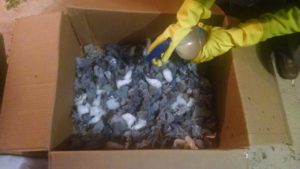Rather than Easter eggs, these objects were homemade “tick tubes,” our attempt to trick mice into poisoning some of the black-legged ticks that want to transmit viruses for Lyme and other diseases into our bloodstreams.
Tick tubes are, as you might expect, small tubes. They are filled with cotton soaked in permethrin, an effective and long-lasting insecticide.
You put them where mice like to scurry, such as next to stone walls or alongside your house foundation. The hope is that white-footed mice – a major carrier of what are often called deer ticks – will take the cotton home and use it to make their nests. There, the poison will kill the ticks riding on the mice, so those eight-legged disease-carriers won’t drop off the mouse’s back in the middle of your yard and then grab you as you walk past.
That’s the hope, anyway. Researchers are cautious about their effectiveness because ticks are brought into our yards by a variety of animals. Entomologist Alan Eaton, UNH’s retired guru of all things bug-related, noted in 2016 that “most field trials had disappointing results.”
But I figure tick tubes can’t hurt, especially since these were free.
You can buy ticks tubes at hardware stores and online, but you can also make your own by soaking cotton balls in permethrin and shoving them inside what small tubes you have.
Some people use permanent tubes such as 6-inch segments of PVC pipe, but I use old cardboard tubes because I’m cheap. In fact, I’m too cheap to buy cotton balls.
My tick-tube experiment got a running start because we already had two dozen old toilet-paper tubes stuffed with dryer lint down in the basement.
I made those as fire-starters for the woodstove because lint from natural fabrics is really combustible. I’ve even put a handful of dryer lint in our winter hiking emergency kit, in case we ever get lost or hurt in the woods and need to quickly light a fire.
My wife and I removed the lint and put it in a box, added some cotton from the tops of medicine bottles, and sprayed it all with a 10 percent permethrin solution, which you can get at your local hardware store. We shoved this mix back in the cardboard tubes (while wearing gloves, of course) and then scattered them around our property.
Will they work? And how will we know?
If the lint disappears, we’ll know that some critters are taking it, but there’s no way to measure any resulting tick death or changes in local arachnid population. All I can do is assume – hope, really – that it will.
In this, using tick tubes is an act of faith, like lighting a candle in church or casting a vote for president. It may not make a difference, but at least it makes me feel better.
If this effort means that just one tick dies a slow, horrible death from insecticide poisoning, it’ll be worth it.



 Return to the Concord Monitor
Return to the Concord Monitor
I agree that the ticks are a nightmare now for those of us that enjoy the outdoors. But I’m not certain about your statement that “tick tubes can’t hurt”. The Cornell Extension Toxicology Network website says in regard to spraying with permethrin:
“Permethrin is extremely toxic to bees. Severe losses may be expected if bees are present at treatment time, or within a day thereafter. Permethrin is also toxic to wildlife. It should not be applied, or allowed to drift, to crops or weeds in which active foraging takes place”.
What are your thoughts about guinea hens?
That’s all correct – as you’d expect from Cornell. It’s why I don’t spray my property for ticks.
But tick tubes are so very focused and specialized in application – the permethrin wears off in a week or two, maybe less – that it seems like the accidental damage is pretty limited.